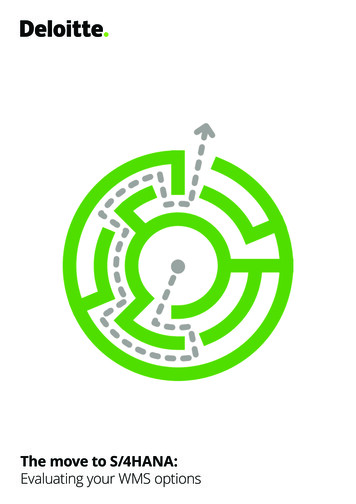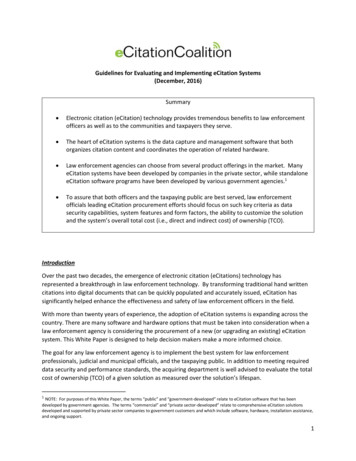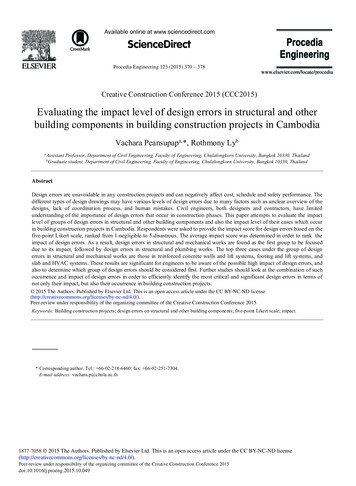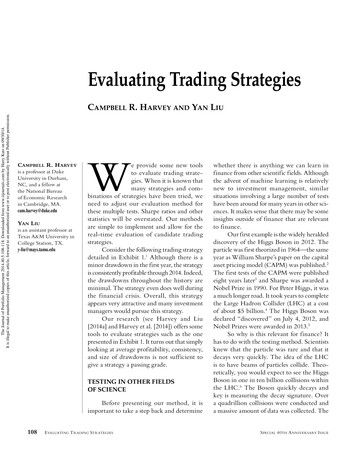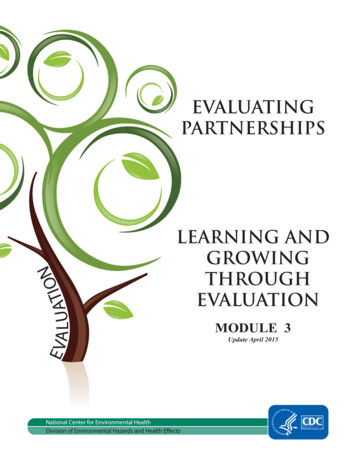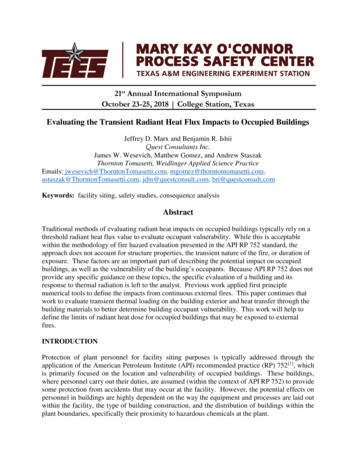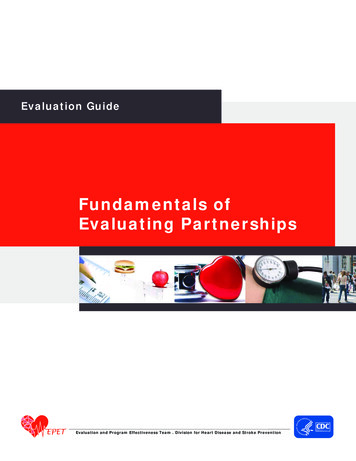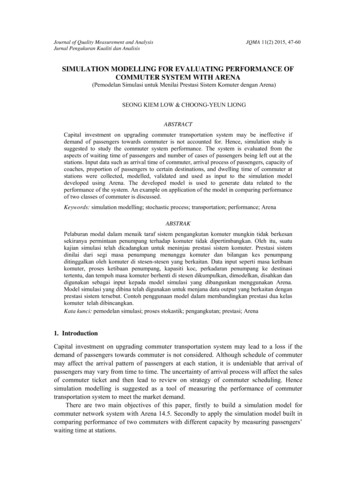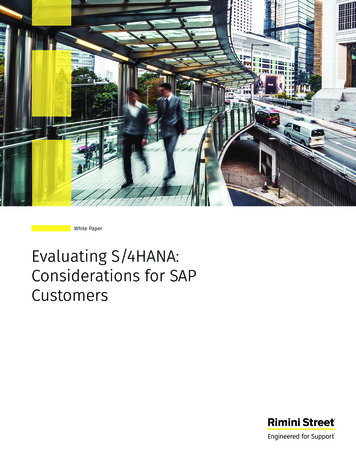
Transcription
White PaperEvaluating S/4HANA:Considerations for SAPCustomers
White Paper2Rimini Street Evaluating S/4HANA: Considerations for SAP Customers
Table of ContentsExecutive Summary4What Is S/4HANA?6Product Maturity7Where Is the Business Case for Migration?9S/4HANA Migration: Risky, Complicated and Expensive10SAP Customer Options12Digital Transformation13Conclusion14Rimini Street Evaluating S/4HANA: Considerations for SAP Customers3
White PaperExecutive SummarySAP launched S/4HANA in February 2015 with muchfanfare, so much so that SAP CEO Bill McDermott declaredS/4HANA the “biggest launch in 23 years, if not in theentire history of the company.”1 Surprisingly, SAP revealedfew details about what S/4HANA could actually do.Simply put, the company essentially retooled its ERP Financials application to runon the SAP HANA database and called it Simple Finance. SAP’s messaging focusedon HANA’s processing speed and reduced data footprint — but failed to describeconvincing and compelling business benefits for its customers. This left manypotential S4/HANA customers and industry analysts scratching their heads overthe lack of detail. Later that year, in November 2015, SAP announced its S/4HANAEnterprise Management on-premise version, which is referred to as the SAP S/4HANA1610 update. Despite minor naming variations, SAP calls S/4HANA its next-generationbusiness suite, and the on-premise Enterprise Management edition replaces theexisting SAP Business Suite.It’s important to know that SAP S/4HANA Enterprise Management is not truly a newproduct. Rather, it derives from the SAP ERP application often referred to as ECC 6.0,and as such it utilizes modules that date back to SAP’s R/3 client-server suite, whichlaunched in 1992. SAP has partially modified these modules—which it calls refactoring—to utilize the proprietary HANA in-memory database, which in turn is marketed asproviding faster query performance and a reduced application data footprint. Fasterspeeds and smaller data footprints can provide some benefits, mainly technical,but SAP has had a hard time articulating any significant functional user benefits.In effect, by creating S/4HANA, SAP has produced the equivalent of offering itscustomers a smaller, faster car for commuting to work on streets that all retain thesame speed limits as before.1 Brian McKenna, ComputerWeekly, SAP unveils S/4Hana as ‘biggest launch in 23 years‘, ni Street Evaluating S/4HANA: Considerations for SAP Customers
SAP intends to utilize a new proprietary user experience with S/4HANA, calledSAP Fiori. To date, Fiori’s use has been delivered very slowly and limited to someapplications that run on S/4HANA. Despite other intentions, the primary UI in S4/HANA remains the legacy SAP GUI.There are more concerns. SAP is not refactoring all ECC 6.0 modules to run on theHANA database. Instead, its strategy is to replace some built-in SAP ERP componentswith new cloud-based applications. For example, SAP replaced the Human Resourcesmodule — a key functional component of the complete SAP ERP product — with asoftware-as-a-service (SaaS)-based HR application from SuccessFactors (acquired in2012) called Employee Central. Yet, SAP describes Enterprise Management as an onpremise product. In reality, it is a hybrid suite that combines both on-premise andmulti-tenant cloud (SaaS) applications.Some of these SaaS products, such as Ariba, Concur and Hybris were acquired by,not written by, SAP. They are used to extend some of S/4HANA’s functional domains.However, these SaaS products are not included in the S/4HANA base license andmust be purchased separately through subscription licensing. In addition to the onpremise version, there are three S/4HANA cloud editions, each of which are made upof disparately acquired SaaS applications.So far, SAP’s S/4HANA has been slow to catch on with existing customers. Severalstudies published by regional SAP user groups cite the lack of a compelling businesscase, as well as raise concerns about the disruption and risk involved in a costlymigration. The German DSAG user group reports that 86 percent of its users saythey are making little or no investment in S/4HANA.2 A report by Nucleus Researchshows a similar lack of interest: 9 out of 10 SAP customers indicated they would notconsider future investments in S/4HANA.3Overall, concerns about risk, cost and disruption are difficult to quantify, primarilybecause there have been so few migrations to help pave and illuminate possible pathsand outcomes. With no customers to discuss their upgrade and migration experiences,it means the costs and benefits remain unclear, if not altogether elusive.SAP documentation provides little insight on cost, but SAP does list requirementsfor migrating to S/4HANA that detail the hardware and software customers needfor the complex data and functionality migrations, as well as the specializedexpertise they will need to install, migrate data and configure their systems. Themigration requirements also raise concerns about existing user customizations,add-ons and integrations that are not supported by S/4HANA, meaning thatenterprises may have to write off important customizations they have alreadymade in their SAP environments.2 2016 DSAG Investment Survey, http://www.dsag.de/3 “6 Out of 10 SAP Customers Wouldn’t Buy Again,” Nucleus Research: 4hanaRimini Street Evaluating S/4HANA: Considerations for SAP Customers5
White PaperAll-in-all, the S/4HANA 1610 update is an incomplete product with unclear businessvalue. The SAP roadmap for existing customers and functional parity with SAP ERP6.0 is vague. The various new — and often separately licensed — components havevaried costs and also lack clarity for existing customers trying to understand theramifications of S/4HANA. The S/4HANA Enterprise Management suite may, overthe next decade, eventually become a robust ERP solution and a viable upgradeoption for existing SAP ERP and Business Suite customers. However, at its currentstage of development, the downside risks in terms of missing functionality andthe costs and risks of re-implementation appear too high. This is particularly truein light of SAP’s mixed track record of developing new products and making themcommercially viable.Despite SAP marketing efforts, most existing SAP customers are taking a wait-andsee approach that lets them leverage their current SAP implementations until theS/4HANA product matures. More importantly, this wait-and-see approach does notmean that customers are standing still.Some enterprises are reducing their upgrade risk by cutting their support andmaintenance costs in half for their existing and stable ERP implementations.This tactic frees up funds that are better spent on focused line-of-businessapps or targeted cloud-based solutions. In effect, this gives SAP time to stabilizeS/4HANA while letting customers move forward without risk. Overall, this type ofinnovate-around-the-edges strategy has been gaining momentum across all ERPimplementations.What Is S/4HANA?SAP based the development of S/4HANA Enterprise Management on the ERP 6.0application. ERP 6.0 was derived from its predecessor, SAP’s client-server suite R/3,which launched in 1992. In 2004, R/3 was re-architected and launched as mySAP ERP.SAP then changed the name to ERP 5.0 and upgraded it to ERP 6.0, which is currentlythe latest release. A key advantage of both R/3 and its successor SAP ERP is the factthat they are database-agnostic and fully support third-party databases, namely theOracle database, IBM DB2 and Microsoft SQL Server.In 2014, SAP announced it had refactored portions of the ERP Financials modules(referred to as FI-CO) to run on the company’s proprietary SAP in-memory HANAdatabase. SAP initially called the product Simple Finance and launched thisconfiguration as the S/4HANA product in early 2015. In November of that year, theS/4HANA 1610 update introduced incremental changes to a broader set of partiallyrefactored ERP modules to provide basic logistics capabilities.Unfortunately for existing SAP ERP customers, SAP is not planning to include all of theECC 6.0 modules in S/4HANA. For example, SAP announced that the ERP-HR module,which comprises a key functional area in ERP, will not be modified to run on the HANAdatabase. Rather, S/4HANA replaces it with SuccessFactor’s Employee Central, which isa multitenant, SaaS-based core HR product originally released in late 2013. S/4HANA1610 introduced additional SaaS applications to extend its incomplete functional6Rimini Street Evaluating S/4HANA: Considerations for SAP Customers
domains. These extensions include Ariba for indirect procurement; Fieldglassfor contingent labor management; Concur for travel and expense; and Hybris foromnichannel e-commerce. It is important to note that these products are separatelylicensed and not included in the S/4HANA foundation license.S/4HANA introduces yet another major hurdle for existing customers: By refactoringthe application code to run on the proprietary SAP HANA database, SAP instantlyended the database agnosticism enjoyed by SAP ERP customers. S/4HANA no longersupports third-party databases from Oracle, IBM or Microsoft. Requiring customersto move to proprietary technology runs counter to technology industry trends ofmoving toward interoperability and open source alternatives.SAP claims HANA’s capabilities allow it to simplify the application functionality byusing the HANA database’s computational speed to eliminate certain aggregateand derived data tables in the application data model. This is like simplifying andremoving part of a car’s engine to give it better performance. This is great, but itpresents new side effects like reducing the availability of tires, repair parts andaftermarket enhancements. For brand-new customers, this isn’t such a problem, butfor existing customers, it also requires new specialized service technicians from apartner ecosystem that doesn’t fully exist.S/4HANA is available in both on-premise and cloud editions. In addition to theon-premise S/4HANA Enterprise Management version, S/4HANA also includes threecloud editions: Enterprise Management Cloud, Professional Services Cloud andMarketing Cloud. All the cloud editions are comprised of the previously describedSaaS products that SAP acquired. The Marketing Cloud uses the SAP-developedCloud for Customer sales and service application.For clarity, it is important to note that SAP uses the term “cloud” very loosely, and itrequires careful attention to make distinctions between the different deploymentmodes for S/4HANA. The on-premise Enterprise Management version (itself a hybridapplication) can be hosted in a managed cloud by a variety of providers includingSAP, Amazon Web Services and more recently, Microsoft on its Azure platform. TheMarketing, Professional Services and Enterprise Management Clouds are all completelydifferent applications and are deployed in a public cloud as SaaS applications.Product MaturityS/4HANA Enterprise Management 1610 is an early-stage product that will requireyears of SAP development effort to fully refactor to deliver the functional scopeof existing SAP ERP and other Business Suite applications. To accomplish this, SAPwould need to potentially rewrite more than 400 million lines of code.4 The 1610update’s functional scope, including some financial and logistics capabilities, issmall in proportion to the ERP application from which it derives.4 “SAP Application Strategies for 2015 and Beyond,” Rimini Street, ies.pdfRimini Street Evaluating S/4HANA: Considerations for SAP Customers7
White PaperSAP has not yet developed other key functional domains (including ERP modulesas well as Business Suite applications such as Supply Chain, Sales and Service).Considering that the on-premise edition is on a yearly release cycle, it may takeSAP well over a decade to deliver functional parity with ECC 6.0 and the BusinessSuite — if SAP even stays the course to deliver functional parity at all. The multipleindustry solutions for which SAP ERP is well known may be even further off on theS/4HANA roadmap.The entirely new architecture and database means customers migrating toS/4HANA will be early adopters and face the inherent risks involved in an immatureapplication and the technology required to run it. In one report, the Germanspeaking SAP User Group (DSAG) notes, “The product is still very new. The percentageof companies who have made it a main investment is in the single figures. We’reagain seeing some of our members taking on the role of pioneers when it comesto deploying new products. However the HANA cloud platform [sic] doesn’t seemto be fully established on the market, with just one percent of survey respondentsplanning to make it their main investment.”5Another challenge is the user interface. Today, S/4HANA uses the SAP GUI, whichis a legacy UI used on SAP ERP and other Business Suite products that SAP firstdeveloped in 1992. SAP intends to replace the SAP GUI with Fiori as a “reimagined”user experience, natively incorporated in S/4HANA. And yet, SAP is far from clear asto how or when Fiori will fully replace the SAP GUI. Release 1610 documents describesome user-based Fiori applications built for the Financials domain; however, thedocumentation provides scant information on the extent to which Fiori will be usedin S/4HANA and how long it will take to rewrite SAP ERP’s transactional screens. Ithas been reported that for SAP to completely replace the legacy SAP GUI in S/4HANA,the company would have to rewrite hundreds of thousands of transactional screens.In one illuminating article on the matter of Fiori, SCM Focus pulls no punches,noting, “The most important thing to know about Fiori is that Fiori will not be areplacement for the SAP GUI, and Fiori only has a very small amount of coverageover the collection of screens that make up the SAP GUI. Therefore, any S/4HANAimplementation will not be assisted here and there by SAP GUI, it will be the primaryinterface of S/4. The customer may develop more apps using Fiori but that is theextent of Fiori.”6What this really means is that the decades-old and much-maligned SAP GUI isthe default interface for S/4HANA — and will be for quite some time. While manyenterprise applications are adopting more intuitive web-based UIs, SAP is asking itscustomers to adopt a new product that still somehow sports a decades-old UI, thesame UI that has garnered customer criticism for years. Chairman and cofounderHasso Plattner said it best, admitting in an interview: “Users told us, ‘Your UI sucks.’”75 2016 DSAG Investment Survey, http://www.dsag.de/6 “What is Actually in the Fiori Box,” SCM Focus, y-fiori-box/7 “The Much Needed Facelift of SAP,” Delaware Consulting, 15/05/the-much-needed-facelift-of-sap/8Rimini Street Evaluating S/4HANA: Considerations for SAP Customers
Where Is the Business Case for Migration?Early on, SAP described S/4HANA as a monumental event for the company, butSAP has continued to struggle with articulating a compelling functional businesscase for S/4HANA that resonates with its SAP ERP customer base. According to arecent survey by the Americas SAP User Group (ASUG), “First and foremost, nearly60 percent said they’re still not seeing a compelling business case to justify theinvestment. That’s down from 75 percent in the 2014 survey but it remains the topsticking point.”8Much of SAP’s messaging has focused on technical features such as faster querytimes and a reduced data footprint, which begs the question: Are faster speeds inERP systems truly important?It depends. The main benefit of S/4HANA’s processing speed is in what Gartnerrefers to as time-bound processes. SAP cites examples of business processes,such as materials requirements planning for manufacturers, where multiple inputsrequire faster processing speeds — particularly as organizations run scenarioplanning with variables such as order volumes, material price variations, inventorylevels and their effects on projected profitability. Improvements for critical timebound processes may justify S/4HANA for some enterprises, but SAP hasn’t providedany benchmarking information on quantifiable performance advantages over whatSAP ERP users are able to accomplish today. For existing SAP ERP customers, the lackof live referenceable customers makes this business case a guessing game.In addition to materials requirements planning, SAP has also claimed that HANA’sprocessing speed will enable the finance function to conduct its periodic closingof the books faster than before. While faster systems are usually appreciated,most financial professionals agree that closing the books is mostly a function ofcommunication with close coordination across multiple people involved in theprocess.9 For these companies, increased processing speeds may not result indemonstrable business value.Diginomica co-founder Dennis Howlett sums up the business case issues: “Weconsistently hear that customers take one look at HANA and balk at its cost, largelybecause the business case is perceptually difficult to make. It’s not just the licensebut the hardware specifications that hobble making standing up [sic] a HANA case.”108 “SAP’s big challenge: proving the business case for Hana,” InfoWorld: ana.html9 “Building Blocks of a Successful Financial Close,” Journal of Accountancy, November 2011.10 “Should SAP open source HANA?” Diginomica, ourcehana/Rimini Street Evaluating S/4HANA: Considerations for SAP Customers9
White PaperS/4HANA Migration: Risky, Complicated andExpensiveNucleus Research reports that one of the greatest customer concerns aboutmigrating to S/4HANA is the potential disruption and risk posed by moving fromtheir existing SAP ERP and other Business Suite applications.11 Overall, a goodmany SAP customers remember the initial pain they had to endure to finallyachieve their stable ERP installations — and they are not interested in revisitingsimilar challenges. Possible business disruptions need to be evaluated against ROIcalculations, of course, but S/4HANA migrations are even more complicated becausemoving to S/4HANA means abandoning third-party databases for a completely newproprietary database.According to Gartner analyst Roxane Edjlali, “The reason the business case forSAP HANA is such a major challenge is because many organizations have largeinvestments in their ERP implementation. They have purchased licenses for theirexisting DBMS—Oracle, IBM and SQL Server—so they need a good business case forswitching their underlying DBMS for HANA.”12Companies have to manage their third-party database licenses very carefully as theyplan a move to S/4HANA so they don’t end up paying a high price for something theydon’t need, which also quickly erodes the business case for S/4HANA. In addition,organizations risk losing customizations and add-ons that won’t work with S/4HANA,and even if they choose to rewrite or rebuild their customizations with S/4HANA,they will still need to find or retrain specialized technical staff to attempt it.It doesn’t end there. A migration to S/4HANA requires additional technologyexpenditures—both hardware and software—and almost always requires specializedconsulting resources, too. Since few existing customers have migrated their ERPinstances to S/4HANA, there are no clear estimates on the costs, risks and level ofeffort involved in migrating.While SAP is not transparent about the costs, risks and level of
SAP based the development of S/4HANA Enterprise Management on the ERP 6.0 application. ERP 6.0 was derived from its predecessor, SAP’s client-server suite R/3, which launched in 1992. In 2004, R/3 was re-architected and launched as mySAP ERP. SAP then changed the name to ERP 5.0 and upgraded it to ERP 6.0, which is currently the latest release.
